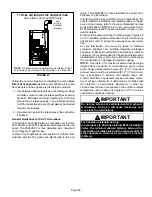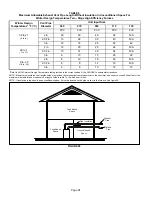
Page 37
One line voltage “HUM” 1/4” spade terminal is pro
vided on the furnace integrated control. Any humidifier
rated up to one amp can be connected to this terminal
with the neutral leg of the circuit being connected to
one of the provided neutral terminals. See Figure 56
for control configuration. This terminal is energized in
the heatingmode whenever the combustion air inducer
is operating.
Install the room thermostat according to the instruc
tions provided with the thermostat. If the furnace is be
ing matched with a heat pump, refer to the instruction
packaged with the dual fuel thermostat.
Indoor Blower Speeds
When the thermostat is set to “FAN ON,” the indoor
blower will run continuously at approximately 50% of
the second stage cooling speed when there is no cool
ing or heating demand.
When the unit is running in the heating mode, the in
door blower will run on the heating speed designated
by the positions of DIP switches (A, B, C, D) of the
HEAT jumper. See figure 53.
When the unit is running in the cooling mode, the in
door blower will run on the cooling speed designated
by the positions of DIP switches (A, B, C, D) of the
COOL jumper. See figure 53.
FIGURE 53
Adjust HEAT and COOL Taps on the
integrated Control
Generator Use - Voltage Requirements
The following requirements must be kept in mind when
specifying a generator for use with this equipment:
S
The furnace requires 120 volts (Range: 102 volts to
132 volts)
S
The furnace operates at 60 Hz + 5% (Range: 57 Hz to
63 Hz)
S
The furnace integrated control requires both correct
polarity and proper ground. Both polarity and proper
grounding should be checked before attempting to op
erate the furnace on either permanent or temporary
power
S
Generator should have a wave form distortion of less
than 5% THD (total harmonic distortion)
Electrical Wiring
The furnace must be grounded and wired in accordance
with local codes or, in the absence of local codes, with the
National Electrical Code ANSI/NFPA No. 70 (latest edition)
and/or CSA C22.1 Electrical Code (latest edition) if an ex
ternal electrical source is utilized
.
In all instances, other than wiring for the thermostat, the
wiring to be done and any replacement of wire shall con
form with the temperature limitation for Type T wire –635F
(355C) rise.
Connect a sufficiently sized wire with ground to the fur
nace's line voltage connections and ground wire. Refer to
the furnace rating plate for electrical characteristics to be
used in sizing field supply wiring and overcurrent protec
tion.
The line voltage supply should be routed through a readily
accessible disconnect located within sight of the furnace.
A junction box on the furnace side panel is provided for line
voltage connections. Refer to the furnace wiring diagram
for specific connection information.
Proper polarity of the supply connections (“HOT” and
“NEUTRAL”) must be observed to ensure that safety
controls provide the protection intended.
A connection to the unit's ground wire and actual earth
ground (typically a ground stake or buried steel pipe) must
be maintained for proper operation.
Thermostat Selection
Install a room thermostat according to the instructions fur
nished with it. Select a location on an inside wall that is not
subject to drafts, direct sunshine, or other heat sources.
The initial heat anticipator setting should be equal to the to
tal current draw of the control circuit. Low voltage thermo
stat connections are to be made to the integrated ignition/
blower control board as indicated on the wiring diagram.
Single Stage Thermostat Operation
The automatic heat staging option allows a single stage
thermostat to be used with two stage furnace models. To
activate this option, move the jumper pin (see Figure 54) to
desired setting (5 minutes or 10 minutes). The furnace will
start on 1st stage heat and stay at 1st stage heat for the
duration of the selected time before switching to 2nd stage
heat.
















































